Table of Content
We can tell you the last scoliometer reading you or your child had on previous examination . The observer examines the patient from behind, looking for an uneven lower back, uneven upper back, or uneven hips. In this procedure, surgeons connect two or more of the bones in the spine together so they can't move independently. Pieces of bone or a bone-like material are placed between the vertebrae.
They’ll also look closely at your spine, shoulders, and hips as you stand and move. Exercise is being recommended more and more as a treatment for mild to moderate scoliosis. By being proactive and performing these exercises, you may be able to slow the curvature of your spine and decrease the pain you feel as a result of your scoliosis. Certain exercises may be prescribed by a physician or physical therapist to help you with your specific structural difference, but they are not a means for treatment. Treatment for moderate to severe scoliosis will most likely involve surgery. Many people however would prefer to start with a self-scoliosis screening prior to visiting a physician.
Scoliosis Test
This kind of posture examination can involve a third party or you can conduct it yourself. Examine your face, and imagine a horizontal line drawn from one eye to another. If you answered yes to any of these questions, you might want to undergo further testing. The most definitive scoliosis tests are tests that cannot be performed outside of a doctor’s office. X-rays will definitively show the extent of curvature of a patient’s spine.

Metal rods, hooks, screws or wires typically hold that part of the spine straight and still while the old and new bone material fuses together. A brace's effectiveness increases with the number of hours a day it's worn. Children who wear braces can usually participate in most activities and have few restrictions. If necessary, kids can take off the brace to participate in sports or other physical activities. Scoliosis can sometimes cause a slight limp or other irregularities while walking.
How Do I Know If I Have Scoliosis?
As the leading cause of spinal deformity amongst school-aged children in the United States, scoliosis is more common than many people think. The largest age group diagnosed with the condition are adolescents between the ages of 10 and 18. If you detect it early, a scoliosis specialist can help with corrective exercise and offer non-invasive therapy. Unfortunately, most cases go undiagnosed until the curve of the spine has progressed and advanced.

There are several proven treatments available for children and adults suffering from ADHD. Keep in mind that this list does not cover all of your scoliosis questions, so you should communicate with your medical team as necessary. Patients with idiopathic scoliosis are usually seen by their doctor once a year for three to four months to monitor the curve. Bracing is the most commonly used treatment for adolescents who have curves greater than 20 degrees and have at least two years of hair growth left on their face. Adults suffering from shoulder and back pain should use moist heat, stretch and strengthen their muscles, and take medication to relieve their pain. Starting treatment early in the treatment process, when the condition is at its most progressive, reduces the likelihood of further complications.
Managing your scoliosis
These disciplines are joined together as a result of the patient’s needs and condition. Self-correction exercises for Scoliosis These exercises are tailored to each patient’s curvature type or ability. The exercises used would consist of movements, isometrics, or reflexives. It is also a good option for mild scoliosis pain management with SSEs.
This ensures that you won’t be harming your skeletal system by performing these exercises. The difference between a typical spine and that of a person with scoliosis, he explains, is that the former can move from side to side. For instance, when you walk, your spine bends and rotates left and right, ultimately reverting back to the center. People with scoliosis have a difficult time moving in one direction due to the curvature of their spine. Aside from screening at your physician’s office, some schools also perform scoliosis checks.
Imaging tests
The alignment of your child’s eyes and ears can also signal a spinal abnormality. Examine your child’s eye line and ears to check for scoliosis red flags. To conduct a scoliosis home screening, perform the following steps with your child. In this position, the bony vertebrae of the spine are protruding and are more pronounced.

Here at the Scoliosis Reduction Center, through our scoliosis-specific chiropractic approach, our patients can experience results in as little as two weeks. With each and every patient, we work towards improving the lives of people with the condition and giving them the tools to do so. Moving through treatment, X-rays will continue to be a crucial tool for monitoring the patient’s rate of progression and the effectiveness of treatment.
Hemlines may no longer appear even, and pants legs or shirt sleeves could seem to have lengthened or shrunk. These changes may signal that your body is experiencing shifts that aren’t otherwise evident. A strong, supportive peer group can have a significant impact on a child's or teen's acceptance of scoliosis, bracing or surgical treatment. Encourage your child to talk to his or her friends and ask for their support. Explore Mayo Clinic studies testing new treatments, interventions and tests as a means to prevent, detect, treat or manage this condition.
Fortunately, you don’t have to start with these more expensive tests. If you’re wondering how to check for scoliosis in a child or adult, there are scoliosis screening techniques you can easily perform at home. However, scoliosis home screening can lead to false positives, and is not a replacement for professional tests.

No comments:
Post a Comment